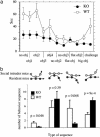Executive and social behaviors under nicotinic receptor regulation
- PMID: 12876201
- PMCID: PMC170963
- DOI: 10.1073/pnas.1533498100
Executive and social behaviors under nicotinic receptor regulation
Abstract
Nicotine enhances several cognitive and psychomotor behaviors, and nicotinic antagonists cause impairments in tasks requiring cognitive effort. To explore the contribution of nicotinic receptors to complex cognitive functions, we developed an automated method to investigate sequential locomotor behavior in the mouse and an analysis of social behavior. We show that, in the beta2-/- mutant, the high-order spatiotemporal organization of locomotor behavior, together with conflict resolution and social interaction, is selectively dissociated from low-level, more automatic motor behaviors. Such deficits in executive functions resemble the rigid and asocial behavior found in some psychopathological disorders such as autism and attention deficit hyperactivity disorder.
Figures




References
-
- Museo, E. & Wise, R. A. (1990) Pharmacol. Biochem. Behav. 37, 113-116. - PubMed
-
- Wesnes, K. & Revell, A. (1984) Psychopharmacology 84, 5-11. - PubMed
-
- Sahakian, B. J., Jones, G., Levy, R., Gray, F. & Warburton, D. (1989) Br. J. Psychiatry 154, 797-800. - PubMed
-
- Grottick, A. J., Wyler, R. & Higgins, G. A. (2000) Psychopharmacology 150, 233-236. - PubMed
-
- Shim, I., Javaid, J. I., Wirtshafter, D., Jang, S. Y., Shin, K. H., Lee, H. J., Chung, Y. C. & Chun, B. G. (2001) Behav. Brain Res. 121, 137-147. - PubMed
Publication types
MeSH terms
Substances
LinkOut - more resources
Full Text Sources
Molecular Biology Databases

